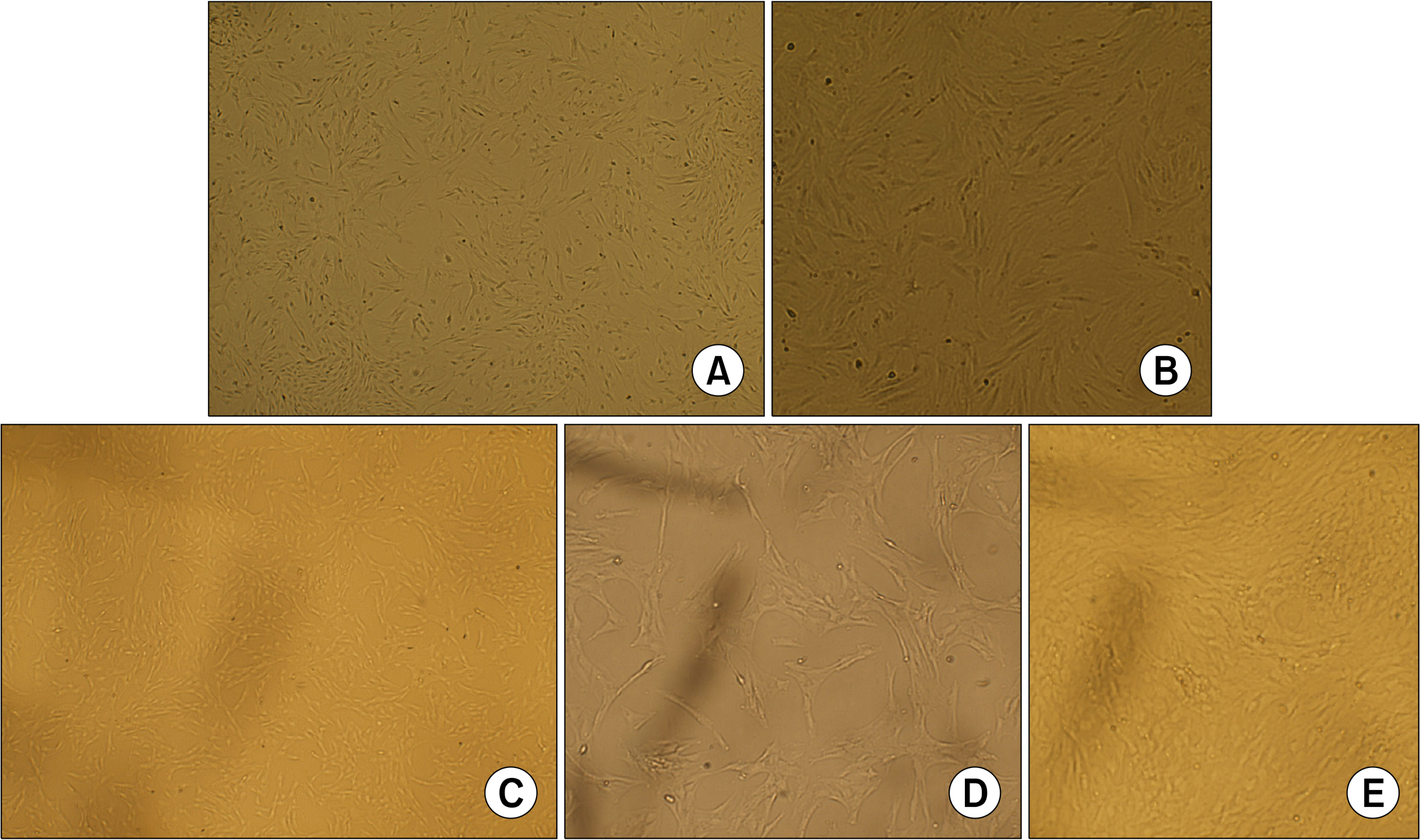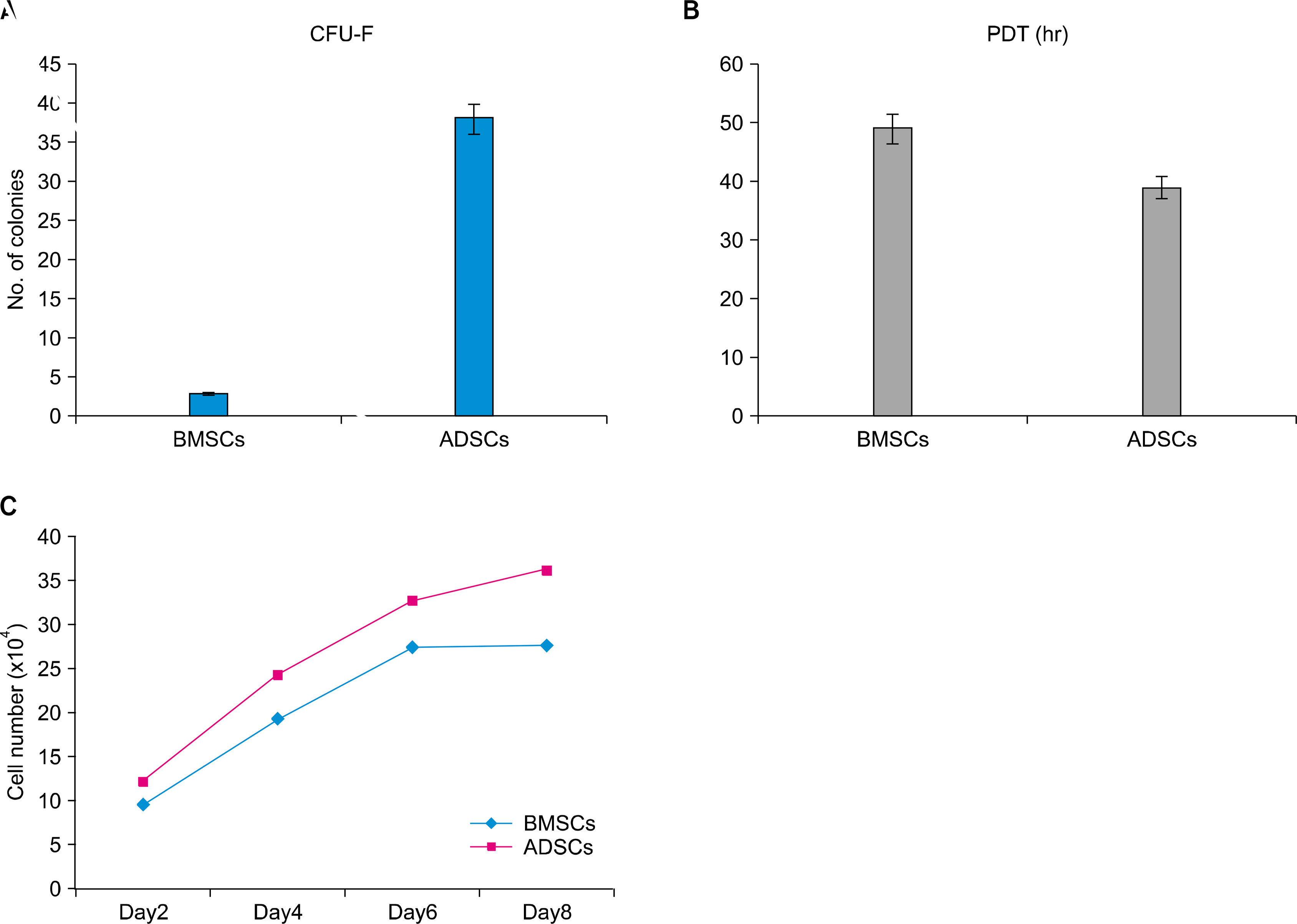Int J Stem Cells.
2014 Nov;7(2):135-142. 10.15283/ijsc.2014.7.2.135.
Characterization of Mesenchymal Stem Cells Derived from Rat Bone Marrow and Adipose Tissue: A Comparative Study
- Affiliations
-
- 1Medical Experimental Research Center (MERC), Faculty of Medicine, Mansoura University, Mansoura, Egypt. lotfy_bio@hotmail.com
- 2Center of Excellence for Stem Cells and Regenerative Medicine (CESCRM), Zewail City of Science and Technology, Egypt.
- 3Biochemistry Department, Faculty of Science, Zagazig University, Egypt.
- 4Leeds Institute of Rheumatic and Musculskeletal Medicine, University of Leeds, Leeds, UK.
- KMID: 1974601
- DOI: http://doi.org/10.15283/ijsc.2014.7.2.135
Abstract
- BACKGROUND AND OBJECTIVES
Stem cell technology offers a new hope for many chronic disorders patients. The types of stem cells are different with many differences existing between each type. Mesenchymal stem cells (MSCs) represent one type of adult stem cells that can be easily isolated, then re-transplanted to the patients. This offers potential for their future application in treating many disorders without fear of rejection possibility. MSCs can be isolated from different sources e.g. bone marrow (BMSCs) and adipose tissue (ADSCs). In the present study we compared BMSCs and ADSCs isolated from Sprague-Dawley rats.
METHODS AND RESULTS
For this comparison, immunophenotyping, the analysis of growth rates, proliferation by colony forming unit-fibroblast assay, population doubling time, and trilineage differentiation assays were performed for both BMSCs and ADSCs. The findings revealed that despite no difference in immunphenotypic character between BMSC and ADSC, a better proliferative capacity was observed for ADSCs which would advocate their better use in regenerative applications. On the other hand, BMSCs showed more potential for osteogenic and chondrogenic differentiation.
CONCLUSIONS
Our study showed that, despite many similarities between both types of cells, there are differences existing which can offer assistance on choosing type of cell to be used in specific diseases. Although ADSCs seem more promising for regenerative application generally, BMSCs may represent a better choice for treating bone disorders.
MeSH Terms
Figure
Cited by 1 articles
-
The Effect of Different Routes of Injection of Bone Marrow Mesenchymal Stem Cells on Parotid Glands of Rats Receiving Cisplatin: A Comparative Study
Eman Hany, Mohammed A. Sobh, Mazen T. Abou ElKhier, Heba M. ElSabaa, Ahmed R. Zaher
Int J Stem Cells. 2017;10(2):169-178. doi: 10.15283/ijsc17022.
Reference
-
References
1. Bongso A, Fong C. Human embryonic stem cells: their nature, properties, and uses. Baharvand H, editor. Trends in stem cell biology and technology. New York, NY: Humana Press;2009. 1–18.
Article2. D’Inverno M, Theise N, Prophet J. Mathematical modeling of stem cells: A complexity primer for the stem-cell biologist. Potten CS, Clarke RB, Wilson J, Renehan AG, editors. Tissue stem cells. New York: Taylor & Francis Group;2006. 1–5.3. Nagy RD, Tsai BM, Wang M, Markel TA, Brown JW, Meldrum DR. Stem cell transplantation as a therapeutic approach to organ failure. J Surg Res. 2005. 129:152–160.4. Satija NK, Singh VK, Verma YK, Gupta P, Sharma S, Afrin F, Sharma M, Sharma P, Tripathi RP, Gurudutta GU. Mesenchymal stem cell-based therapy: a new paradigm in regenerative medicine. J Cell Mol Med. 2009. 13:4385–4402.
Article5. Yang KL, Shyr MH. Are Stem Cells the Magical Medical Therapy of the Future? Tzu Chi Med J. 2009. 21:12–17.
Article6. Liu W, Deng Y, Liu Y, Gong W, Deng W. Stem cell models for drug discovery and toxicology studies. J Biochem Mol Toxicol. 2013. 27:17–27.
Article7. Jiang Y, Jahagirdar BN, Reinhardt RL, Schwartz RE, Keene CD, Ortiz-Gonzalez XR, Reyes M, Lenvik T, Lund T, Blackstad M, Du J, Aldrich S, Lisberg A, Low WC, Largaespada DA, Verfaillie CM. Pluripotency of mesenchymal stem cells derived from adult marrow. Nature. 2002. 418:41–49.
Article8. Caplan AI. Adult mesenchymal stem cells for tissue engineering versus regenerative medicine. J Cell Physiol. 2007. 213:341–347.
Article9. Tae SK, Lee SH, Park JS, Im GI. Mesenchymal stem cells for tissue engineering and regenerative medicine. Biomed Mater. 2006. 1:63–71.
Article10. Strioga M, Viswanathan S, Darinskas A, Slaby O, Michalek J. Same or not the same? Comparison of adipose tissue-derived versus bone marrow-derived mesenchymal stem and stromal cells. Stem Cells Dev. 2012. 21:2724–2752.
Article11. Bruno S, Bussolati B. Therapeutic effects of mesenchymal stem cells on renal ischemia-reperfusion injury: a matter of genetic transfer? Stem Cell Res Ther. 2013. 4:55.
Article12. Mobasheri A, Csaki C, Clutterbuck AL, Rahmanzadeh M, Shakibaei M. Mesenchymal stem cells in connective tissue engineering and regenerative medicine: applications in cartilage repair and osteoarthritis therapy. Histol Histopathol. 2009. 24:347–366.13. Reich CM, Raabe O, Wenisch S, Bridger PS, Kramer M, Arnhold S. Isolation, culture and chondrogenic differentiation of canine adipose tissue- and bone marrow-derived mesenchymal stem cells--a comparative study. Vet Res Commun. 2012. 36:139–148.
Article14. Kisiel AH, McDuffee LA, Masaoud E, Bailey TR, Esparza Gonzalez BP, Nino-Fong R. Isolation, characterization, and in vitro proliferation of canine mesenchymal stem cells derived from bone marrow, adipose tissue, muscle, and periosteum. Am J Vet Res. 2012. 73:1305–1317.
Article15. Nakanishi C, Nagaya N, Ohnishi S, Yamahara K, Takabatake S, Konno T, Hayashi K, Kawashiri MA, Tsubokawa T, Yamagishi M. Gene and protein expression analysis of mesenchymal stem cells derived from rat adipose tissue and bone marrow. Circ J. 2011. 75:2260–2268.
Article16. Zhang W, Zhang X, Wang S, Xu L, Zhang M, Wang G, Jin Y, Zhang X, Jiang X. Comparison of the use of adipose tissue-derived and bone marrow-derived stem cells for rapid bone regeneration. J Dent Res. 2013. 92:1136–1141.
Article17. Melief SM, Zwaginga JJ, Fibbe WE, Roelofs H. Adipose tissue-derived multipotent stromal cells have a higher immunomodulatory capacity than their bone marrow-derived counterparts. Stem Cells Transl Med. 2013. 2:455–463.
Article18. Nadri S, Soleimani M. Isolation murine mesenchymal stem cells by positive selection. In Vitro Cell Dev Biol Anim. 2007. 43:276–282.
Article19. Bunnell BA, Flaat M, Gagliardi C, Patel B, Ripoll C. Adipose-derived stem cells: isolation, expansion and differentiation. Methods. 2008. 45:115–120.
Article20. Jones EA, English A, Henshaw K, Kinsey SE, Markham AF, Emery P, McGonagle D. Enumeration and phenotypic characterization of synovial fluid multipotential mesenchymal progenitor cells in inflammatory and degenerative arthritis. Arthritis Rheum. 2004. 50:817–827.
Article21. Boxall SA, Jones E. Markers for characterization of bone marrow multipotential stromal cells. Stem Cells International. 2012. 2012:975871.
Article22. Asumda FZ, Chase PB. Age-related changes in rat bone-marrow mesenchymal stem cell plasticity. BMC Cell Biol. 2011. 12:44.
Article23. Katsara O, Mahaira LG, Iliopoulou EG, Moustaki A, Antsaklis A, Loutradis D, Stefanidis K, Baxevanis CN, Papamichail M, Perez SA. Effects of donor age, gender, and in vitro cellular aging on the phenotypic, functional, and molecular characteristics of mouse bone marrow-derived mesenchymal stem cells. Stem Cells Dev. 2011. 20:1549–1561.
Article24. Zhu Y, Liu T, Song K, Fan X, Ma X, Cui Z. Adipose-derived stem cell: a better stem cell than BMSC. Cell Biochem Funct. 2008. 26:664–675.
Article25. Sun CK, Yen CH, Lin YC, Tsai TH, Chang LT, Kao YH, Chua S, Fu M, Ko SF, Leu S, Yip HK. Autologous transplantation of adipose-derived mesenchymal stem cells markedly reduced acute ischemia-reperfusion lung injury in a rodent model. J Transl Med. 2011. 9:118.
Article26. Peng L, Jia Z, Yin X, Zhang X, Liu Y, Chen P, Ma K, Zhou C. Comparative analysis of mesenchymal stem cells from bone marrow, cartilage, and adipose tissue. Stem Cells Dev. 2008. 17:761–773.
Article27. Yoshimura H, Muneta T, Nimura A, Yokoyama A, Koga H, Sekiya I. Comparison of rat mesenchymal stem cells derived from bone marrow, synovium, periosteum, adipose tissue, and muscle. Cell Tissue Res. 2007. 327:449–462.
Article28. Rebelatto CK, Aguiar AM, Moretão MP, Senegaglia AC, Hansen P, Barchiki F, Oliveira J, Martins J, Kuligovski C, Mansur F, Christofis A, Amaral VF, Brofman PS, Goldenberg S, Nakao LS, Correa A. Dissimilar differentiation of mesenchymal stem cells from bone marrow, umbilical cord blood, and adipose tissue. Exp Biol Med (Maywood). 2008. 233:901–913.
Article29. Im GI, Shin YW, Lee KB. Do adipose tissue-derived mesenchymal stem cells have the same osteogenic and chondrogenic potential as bone marrow-derived cells? Osteoarthritis Cartilage. 2005. 13:845–853.
Article
- Full Text Links
- Actions
-
Cited
- CITED
-
- Close
- Share
- Similar articles
-
- Concise Review: Differentiation of Human Adult Stem Cells Into Hepatocyte-like Cells In vitro
- Characterization of multipotent mesenchymal stem cells isolated from adipose tissue and bone marrow in pigs
- Expression of surface markers and myogenic potential of rat bone marrow- and adipose-derived stem cells: a comparative study
- Adipose Tissue Derived Mesenchymal Stem Cells
- Adipose-derived stem cells: characterization and clinical application




